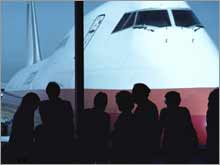|
Fly the crowded skies
Filled flights, higher fares could be the rule this summer as airlines cut domestic capacity.
NEW YORK (CNNMoney.com) - Growing demand for airline travel, coupled with a tighter supply of seats, means there's likely to be few or no empty seats on your next flight, especially if that flight is this summer. And it's quite possible you'll be paying a higher fare for your next ticket, given the scarcity of seats.
The nation's 10 largest airlines filled 81.1 percent of their available seats in April, the highest reading for that ratio known as "load factor" ever seen in April. That follows a March when the industry as a whole filled 81.8 percent of its seats, also the highest reading ever for that period. Over the first four months of the year, the 10 largest airlines have filled 78.2 percent of the seats, a higher load factor than was seen in the three busy summer months right before the Sept. 11 terrorist attack shook the industry and flyer confidence. The first four months of last year, the same carriers filled 75.8 percent of seats. Part of the high load factor is due to a 5 percent increase in miles flown by paying passengers during April compared to a year earlier. But part of it is also due to a number of troubled airlines trimming capacity over the last 12 months, leaving the industry with essentially flat capacity in the face of growing demand. Two carriers that filed for bankruptcy in September, Delta Air Lines (Research) and Northwest Airlines (Research), cut capacity by 8 and 10 percent, respectively, over the first four months of the year compared to a year earlier. The current US Airways (Research), which was formed when America West bought the then bankrupt US Air last year, has 11 percent fewer seats available than those two carriers did combined a year ago. Domestic squeeze
The squeeze is even greater on domestic flights. The U.S. carriers with international flights nearly all report their highest load factors on their domestic routes. And even though growing carriers such as Southwest Airlines (Research) and JetBlue (Research) are adding planes and routes to their domestic service, figures from the Air Transport Association (ATA), the industry trade group, shows there will be 2.3 percent fewer seats available on domestic flights this summer. That compares to 4.7 percent more capacity on international flights, with both U.S. and foreign carriers counted. The squeeze comes ahead of the traditionally busy summer travel season. Over the last decade, industrywide load factors have risen by an average of 9 percentage points over the ratio seen during the first four months of the year. The highest monthly load factor in history - 85.2 percent - was recorded in July 2005. But a big seasonal increase this year would take the average summer load factors to levels of near or perhaps even above 90 percent. Given that a few seats on planes are used by non-paying passengers such as non-active crew members, federal air marshals and airline employees flying on standby, a 90 percent load factor is getting close to a full plane on every flight. "You can't be at 100 percent," said John Heimlich, chief economist for the ATA trade group. "Of course the prevailing wisdom used to be we'd never reach 80 percent load factors." Heimlich said he couldn't comment on fares expected this summer, but he points out that yield, or the amount paid per mile flown, was up 10.5 cents in the first quarter compared to a year earlier. "Based on current capacity levels, and the improving demand we have seen, I don't see any reason for that trend to change through the summer," he said. Fuel factor
The airlines are all dealing with higher jet fuel costs, which now represents the largest cost at most carriers. In the past, long-term fuel contracts held by Southwest Airlines have allowed that low-fare carrier to keep its costs down and its fares low, which in turn has kept downward pressure on domestic fares. But Southwest itself is seeing higher fuel costs as its earlier contracts expire and it has been quietly raising fares as well. "The standard Southwest sale two years ago was $39 to $99. Then it was $39 to $109. Now they're saying simply 'Fares starting at $49,'" said Joe Brancatelli, the editor and publisher of Joesentme.com, a non-commercial Web site for business travelers. But Brancatelli said even with higher fuel prices and tight capacity, he thinks that some of the business fares could soon start to fall from the current levels. "They're raising the fares even as we speak, but then they'll find the business travelers paying the walk-up fares will pull back from flying, and they'll have to put on fare sales," he said. "It's almost inexplicable, but we've been through this cycle many times before." The other thing that could limit fare increases, and ease the seat squeeze, is airlines rushing to add flights to try to cash in on the expected space crunch. "That's another thing that limits industry load factors," said Heimlich. "Someone will increase frequency to try to steal market share." --
For a look at how the nation's major airlines are expected to return to profitability this quarter, click here. |
|

